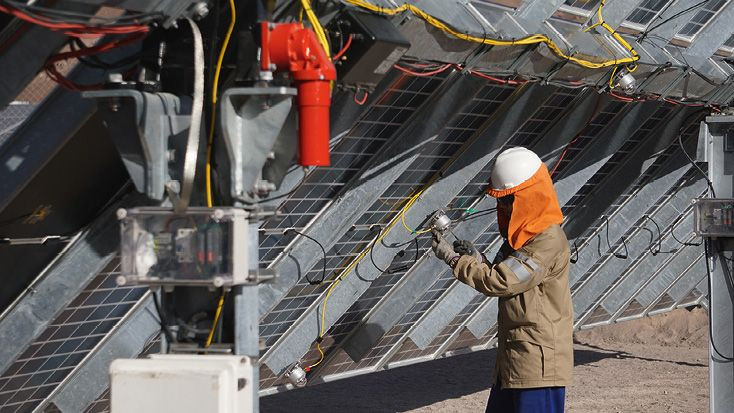Although an accurate assessment of solar resources is key to ensuring the reliability of an energy yield assessment, most studies rely exclusively on satellite irradiation data. Solar developers rarely dedicate resources to installing a weather station to obtain ground-measured data before PV project construction, mainly because of the significant costs involved. Operating a weather station for a year costs between €40,000 ($43,000) and €60,000. A satellite dataset costs several hundred euros.
The development of bifacial modules has complicated the assessment of available solar resources. Irradiation arriving at the rear side of bifacial modules is mainly determined by albedo, which is the ratio between downward irradiation reaching the ground and the upwelling irradiation reflected by it. As with other data, such as global or diffuse irradiation, albedo can be obtained from satellite imagery. Leading data providers also offer this information. Albedo is more difficult to assess than downward irradiation, as it is influenced mainly by the nature of soil. Satellite data resolution is, at best, around 1 km² and the nature of soil, and hence albedo, can significantly vary over such a relatively small area. Albedo will also vary during a day, depending on factors such as the position of the sun, the season, and the weather. A slightly erroneous albedo value can easily cause a 0.5% impact in a yield assessment that could affect project valuations by significant amounts of money.
These factors lead us to the conclusion that albedo should be measured. Nevertheless, the cost of a one-year campaign is still a “no-go” for most developers. Alternatively, some service providers propose short-term measurement campaigns where the albedo is measured on site for one or several days. This measurement is then used to calibrate satellite albedo data.
Short-term benefits
Since Everoze is often asked to use data corrected with short-term albedo measurements, we wanted to forge our own opinion on the benefits of such short-term measurements. We used publicly available, quality-checked weather station measurements, including global irradiation and albedo figures, and analyzed the effect of calibrating this data with short-term albedo measurements from one-day and seven-day campaigns.
We used data from the Surface Radiation Budget Network (SURFRAD) from seven sites in the United States. High-resolution data have been extracted for six years, from 2017 to 2022, and used to calculate a monthly reference albedo for each of those sites, averaged over the six years. For instance, the reference albedo for January was the average of all January albedo values from 2017 to 2022. We also downloaded satellite albedo data from the Prospect tool of solar irradiance data company SolarGIS for the seven locations.
Everoze applied several quality checks to the SURFRAD data, which led to the elimination of a negligible number of days over the six-year period. We then used the albedo of every single day as one-day campaigns and rolling seven-day periods as weekly campaigns, correcting all the satellite data based on these campaigns. Finally, with solar design tool PVsyst, we simulated a theoretical single-axis tracking, bifacial PV asset and ran yield scenarios featuring the six-year average SURFRAD albedo, raw satellite albedo, and satellite albedo.
We compared the yields. The measurement campaign was considered beneficial if the difference between SURFRAD data and the corrected albedo was lower than the difference between SURFRAD and the raw satellite albedo. The figure below illustrates the results for one-day and seven-day campaigns for each of the seven project sites.

Value for money
The results showed one-day campaigns should be discarded because they are not beneficial in most cases, in particular during the winter. Seven-day campaigns are mostly beneficial in the summertime. The author noted that data from other regions may lead to different conclusions. Other factors such as location, height, calibration, and the cleaning frequency of the albedometer should be considered with care. Everoze recommends making the investment to cover a full year of measurements, rather than only a few days. It may be costly in the short term but worth it over a project lifetime.
 About the author: Stefan Mau is an electrical engineer and has been working in solar since 1999, including in R&D, testing and certification, measurement, and consultancy services in Spain, Germany, and Austria. Before joining Everoze, he was global contact for operational services in PV plants at DNV GL. At Everoze, he supports commercial PV services such as due diligence, bankability, and energy assessments and training. He is part of the Spanish standardization committee for PV modules and holds one patent.
About the author: Stefan Mau is an electrical engineer and has been working in solar since 1999, including in R&D, testing and certification, measurement, and consultancy services in Spain, Germany, and Austria. Before joining Everoze, he was global contact for operational services in PV plants at DNV GL. At Everoze, he supports commercial PV services such as due diligence, bankability, and energy assessments and training. He is part of the Spanish standardization committee for PV modules and holds one patent.
The views and opinions expressed in this article are the author’s own, and do not necessarily reflect those held by pv magazine.
This content is protected by copyright and may not be reused. If you want to cooperate with us and would like to reuse some of our content, please contact: editors@pv-magazine.com.








By submitting this form you agree to pv magazine using your data for the purposes of publishing your comment.
Your personal data will only be disclosed or otherwise transmitted to third parties for the purposes of spam filtering or if this is necessary for technical maintenance of the website. Any other transfer to third parties will not take place unless this is justified on the basis of applicable data protection regulations or if pv magazine is legally obliged to do so.
You may revoke this consent at any time with effect for the future, in which case your personal data will be deleted immediately. Otherwise, your data will be deleted if pv magazine has processed your request or the purpose of data storage is fulfilled.
Further information on data privacy can be found in our Data Protection Policy.